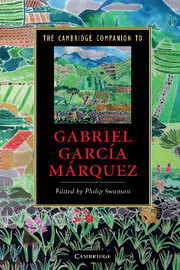Book contents
- Frontmatter
- Introduction
- 1 Gabriel García Márquez: life and times
- 2 The critical reception of García Márquez
- 3 Before One Hundred Years of Solitude: the early novels
- 4 One Hundred Years of Solitude
- 5 An eco-critical reading of One Hundred Years of Solitude
- 6 The Autumn of the Patriarch
- 7 The General in His Labyrinth
- 8 García Márquez’s novels of love
- 9 García Márquez’s short stories
- 10 García Márquez’s non-fiction works
- 11 García Márquez and film
- 12 García Márquez, magical realism and world literature
- Further reading
- Index
2 - The critical reception of García Márquez
Published online by Cambridge University Press: 28 September 2010
- Frontmatter
- Introduction
- 1 Gabriel García Márquez: life and times
- 2 The critical reception of García Márquez
- 3 Before One Hundred Years of Solitude: the early novels
- 4 One Hundred Years of Solitude
- 5 An eco-critical reading of One Hundred Years of Solitude
- 6 The Autumn of the Patriarch
- 7 The General in His Labyrinth
- 8 García Márquez’s novels of love
- 9 García Márquez’s short stories
- 10 García Márquez’s non-fiction works
- 11 García Márquez and film
- 12 García Márquez, magical realism and world literature
- Further reading
- Index
Summary
Serious criticism of Gabriel García Márquez began in the late 1960s, with a particular breakthrough in 1967, the year of One Hundred Years of Solitude (Cien años de soledad). Before that critical date, however, Volkening, Loveluck and Harss (who is said to have introduced the term 'Boom') had already recognised that a potentially important new figure had emerged in Spanish American fiction. Early criticism of the Boom tended to approach early Boom fiction from standpoints associated with readings of older regional novels by writers such as Ricardo Güiraldes and Rómulo Gallegos in the 1920s. Thus Volkening begins by lamenting the tendency to relate contemporary Spanish American fiction to European and North American models (Joyce, Faulkner) and demanding that the 'criollo (i.e. Spanish American) author' be evaluated on his own terms. He goes on to suggest that García Márquez (before One Hundred Years of Solitude, of course) continues the creative pattern of the regional novel but with 'new means of expression'. At the same time, however, like Ángel Rama in the following year, he emphasises the 'dry realism' of García Márquez's style and his tone of social protest. This was not how much future criticism would develop. Loveluck, on the other hand, immediately emphasises García Márquez's newness and associates it right away with 'overcoming outworn nativist and costumbrist formulae'. It is noteworthy that at this point the idea of the Boom had not yet gelled, and Loveluck places García Márquez correctly alongside Carlos Fuentes, José Donoso and Mario Vargas Llosa, but allows Rosario Castellanos, Enrique Lafourcade and David Viñas to get into the act.
- Type
- Chapter
- Information
- The Cambridge Companion to Gabriel García Márquez , pp. 25 - 40Publisher: Cambridge University PressPrint publication year: 2010
- 2
- Cited by

